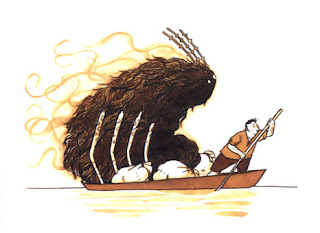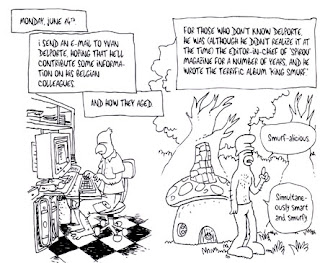Eleanor Davis’s “Seven Sacks” builds mounting disquiet as a succession of even larger and more menacing creatures hire a ferryman to take them across a river. In this panel, Davis conveys both the looming presence of one of the creatures, its bulk threatening to unbalance the ferry, and the nervousness that is building in the ferryman.

There is no need, here in comics, to break away from the narrative to describe the creature and its effects, as would be necessary in prose. And, unlike in film or video, the picture can be focused on the elements the author wants to get across, with no distractions from movement or sound.
In this sequence from “Now Then”, Paul Hornschemeier makes use of the way that we see both the page and the individual elements of the page at the same time. In a play by Beckett or Pinter, long silences tend to be tense because the audience does not know when they will end and how. Here, though, the reader cannot help but be aware that the initial space will soon give way to ordered panels with clean colours, even if we have yet to learn the details of what those panels contain. The effect is a calm, clean sort of pause.

Hornschemeier also makes use of comics’ ability to present multiple strands of narration at once. Here he undercuts his somewhat pretentious caption boxes with humorous ballooned dialogue. Video and audio media can attempt this, as in the overlapping dialogue of Robert Altman films, but they risk disruption or confusion. In comics, the reader can hold several registers in mind without mixing them.
Lewis Trondheim uses a similar effect. The role that the comics form plays in his “At Loose Ends” is, to a large extent, that of sugaring the pill. Want to read a disquisition on ageing as illustrated by the unhappy lives of Franco-Belgian cartoonists? Probably not. But wait! It is told by a cute anthropomorhic parrot. And our interest is held by the introduction of a diversity of images, and even of styles of narration (at times, we get transcipts of e-mails, at others, the monologue becomes a conversation) in a way that would seem forced or distracting in another medium, but is entirely natural to comics.

Panels
“Seven Sacks” by Eleanor Davis
“Now Then” by Paul Hornschemeier
“At Loose Ends”, part 2, by Lewis Trondheim
All published in Mome issue 7, Spring 2007, Fantagraphics Books
No comments:
Post a Comment